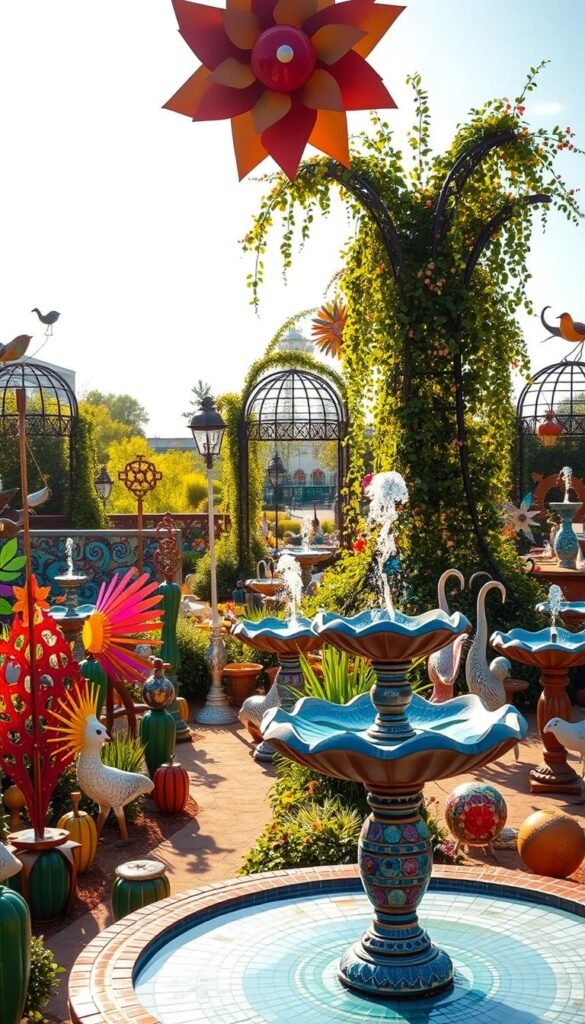Your garden is more than just plants and soil—it’s a living canvas waiting for creative touches. As Wendy Diaz, NC State Extension Master Gardener volunteer notes, decorative features shine brightest in winter. When foliage thins, these accents fill empty spaces while guiding the eye through your landscape like natural waypoints.
Imagine turning your yard into a dynamic outdoor sanctuary. Strategic placements—like metallic sculptures or terracotta pots—add warmth and visual appeal year-round. These pieces create focal points that define “outdoor rooms”, making even small areas feel intentional. For inspiration on elevating your outdoor space, consider how wall-mounted planters or sculptural succulents can blend practicality with artistry.
Beyond beauty, garden accents serve multiple roles. They attract wildlife, mark pathways, and create cozy nooks for relaxation. Even simple DIY projects can boost property value while reflecting your unique style. Whether you choose bold installations or subtle details, every addition tells a story—and keeps your space inviting through every season.
The Intersection of Garden Design and Art
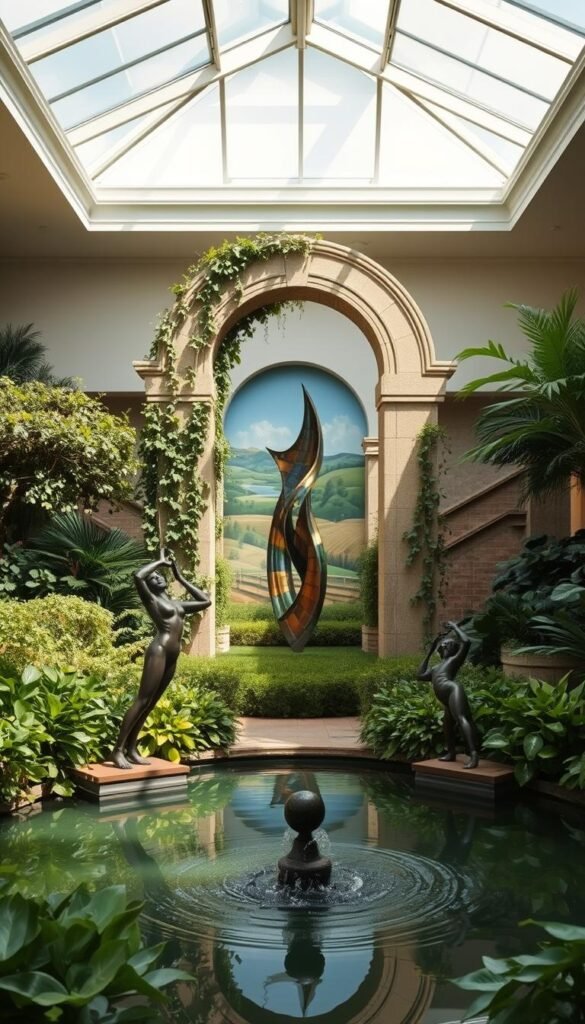
Think of your outdoor space as a gallery where nature and creativity collaborate. Strategic placement of artistic focal points transforms ordinary areas into intentional destinations, guiding visitors through your landscape like a visual compass.
Exploring Art as a Focal Point
Artworks do more than decorate—they command attention and direct movement. A well-placed sculpture or water feature becomes a natural stopping point, especially when visible from multiple angles like pathways or windows. This creates rhythm, pulling viewers deeper into your space.
Creating Inviting Outdoor Rooms
Divide your yard into functional zones using art as room dividers. Larger areas might feature bold metal installations, while cozy nooks shine with delicate ceramic pieces. These “rooms” could host dining areas or quiet retreats, each anchored by artwork that matches their purpose.
Scale matters here. Oversized pieces overwhelm small spaces, but a cluster of smaller works can create intrigue. Always consider sightlines—position art where it surprises and delights, whether glimpsed through foliage or framed by archways.
Drawing Inspiration from Garden Art Installations
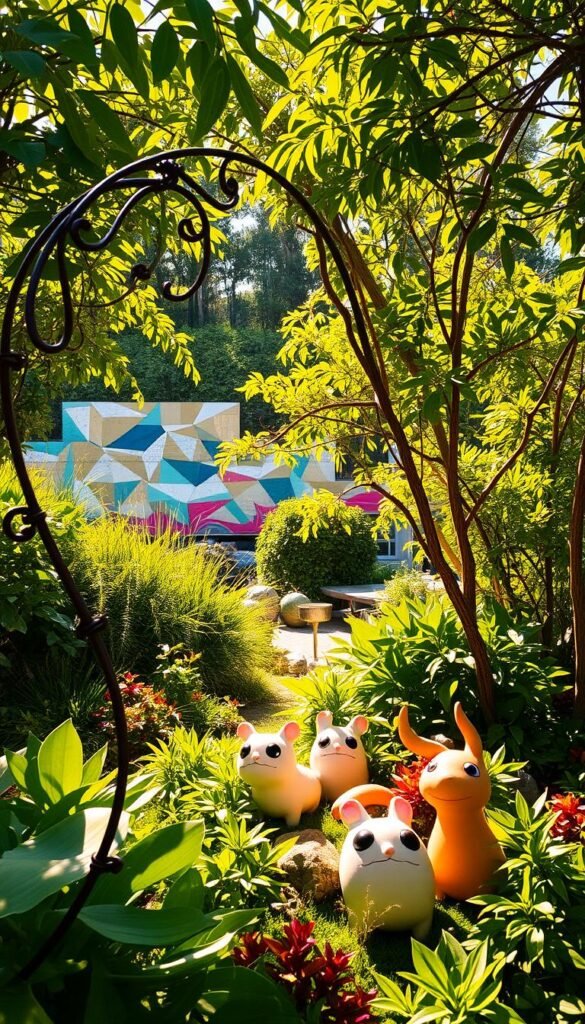
Great gardens tell stories through their landscapes. You can discover fresh ideas by observing how professionals blend artwork with nature. Start by visiting spaces like the Biltmore Estate, where Dale Chihuly’s glass towers sparkle against ivy-covered walls.
Learning Through Real-World Examples
Chihuly’s “Electric Yellow and Deep Coral Tower” shows how bold glass sculptures energize formal gardens. Closer to home, the North Carolina Botanical Garden hosts rotating exhibits featuring bronze family figures by Edwin & Veronica Dam de Nogales. These pieces demonstrate how art creates emotional connections in green spaces.
Local events like “Sculpture in the Garden” let you see steel creations beside native plants. You might spot reflective figures that mirror autumn leaves or playful abstract shapes near pathways. These installations prove art doesn’t just decorate—it invites you to pause and engage.
Blending Timeless and Contemporary Styles
Classical Roman statues still influence modern design, but today’s artists push boundaries. Imagine sleek metal curves winding through boxwood hedges or mosaic murals brightening stone walls. The key lies in balancing materials—try pairing weathered concrete with delicate glass accents.
Some gardens mix eras brilliantly. At New York Botanical Garden, Chihuly’s “Sole d’Oro” golden spheres glow beneath historic pergolas. This contrast makes both the art and architecture stand out. Your space could echo this approach with terracotta fragments embedded in a modern water feature.
Adding Artistic Elements to Garden Design: Sculptures, Murals, and Installations
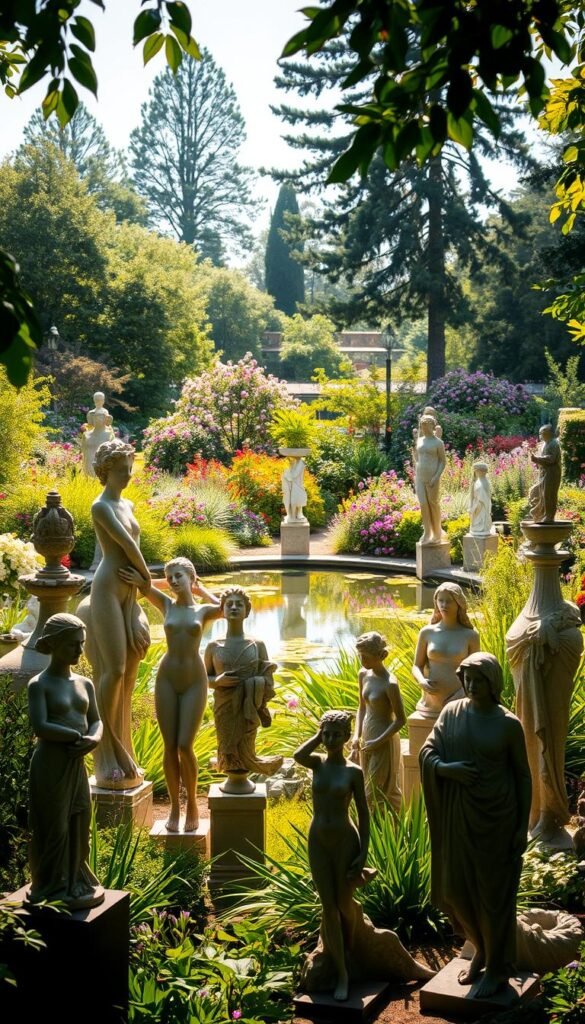
Your outdoor area becomes an extension of your personality when curated with intentional artistry. The right sculpture or handcrafted piece acts like a signature—distinctive yet harmonious with its surroundings. Start by asking: Does this artwork feel like “me”? Does it elevate my garden’s story?
Selecting the Perfect Art Piece for Your Space
Let your landscape guide your choices. A cottage-style space thrives with playful metal creatures peeking through plants, while modern minimalist yards demand sleek geometric forms. Match materials to your environment—weathered stone blends into woodland settings, while polished steel pops against lush greenery.
Consider scale and sightlines. A towering sculpture works best as a central focal point, while smaller pieces create discovery moments along winding paths. For vegetable patches, try DIY garden art like mosaic-topped stakes that add color without overwhelming crops.
Mixing Natural Landscapes with Unique Artworks
Blend manmade and organic elements by echoing nature’s palette. Rust-toned metal artwork complements autumn maples, while cerulean glass orbs mirror spring skies. Position pieces to interact with sunlight—a perforated metal screen casts evolving shadows across your space throughout the day.
Use elevation changes strategically. Place a bronze heron statue where it appears to wade through groundcover, or install floating shelves on retaining walls to display ceramic accents. This layered approach creates depth while keeping your garden feeling cohesive.
Step-by-Step Guide to Incorporating Garden Art
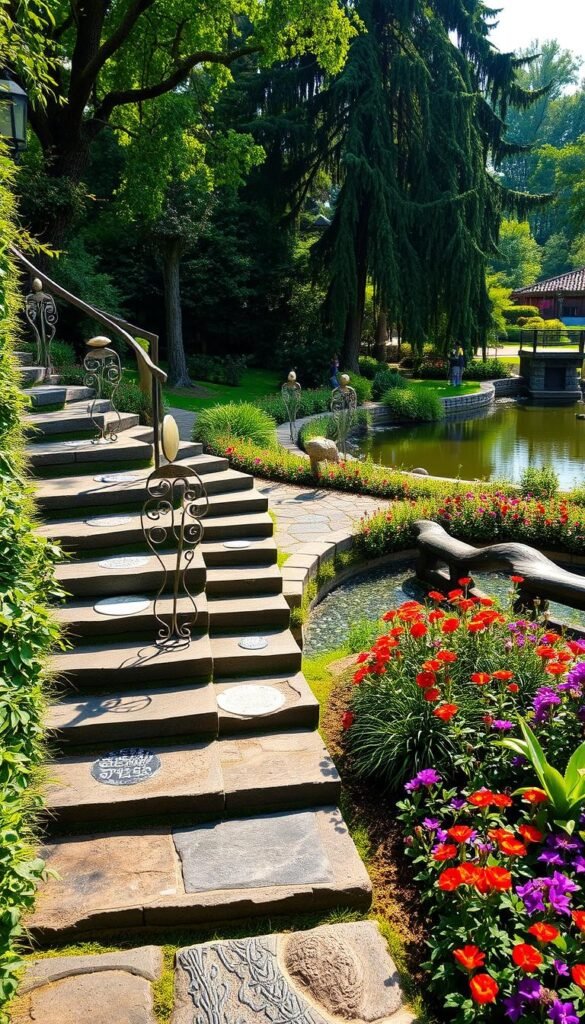
Transforming your outdoor space into an artistic retreat requires thoughtful preparation. Start by sketching your vision—this helps balance creativity with practical considerations like sunlight patterns and foot traffic flow.
Planning and Preparing Your Garden Area
Map your space using measuring tape or digital tools. Note where art will work best—like near seating areas or along pathways. For murals, clean surfaces thoroughly. Remove dirt with eco-friendly cleaners, then sand and prime fences for better paint adhesion.
Consider seasonal impacts. Spring installations prevent soil compaction in wet ground. Always check for underground utilities before digging. Local artists can create custom pieces that fit your exact needs, whether you’re enhancing rose beds or wildflower zones.
Installation Tips and Finishing Touches
Gather weatherproof materials like concrete and rust-resistant fasteners. Anchor sculptures securely—uneven ground causes tipping. For murals, apply matte varnish followed by wood sealer to protect colors.
Adjust angles during golden hour for perfect shadow play. Step back frequently to assess placement. As one expert suggests, “Art becomes part of the landscape when it feels discovered, not placed.”
Need more ideas? Explore garden art project strategies that blend creativity with practicality. Your final touch? A protective sealer ensures years of enjoyment.
Tips and Techniques for Harmonious Outdoor Art Integration
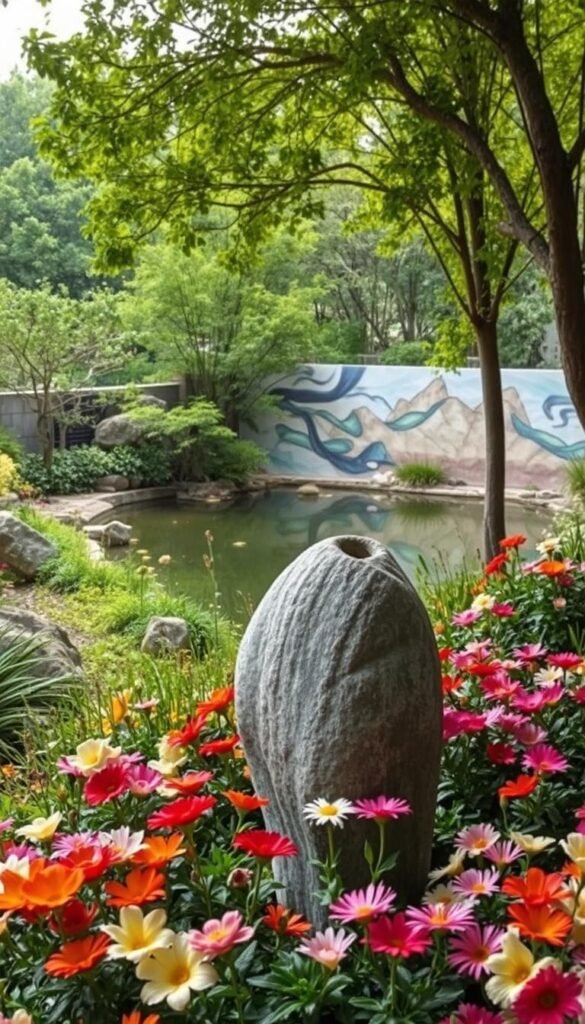
Blending art with nature requires a thoughtful approach where every detail enhances your space. Start by assessing how lighting, color, and scale interact with your existing landscape. These elements work together to create focal points that guide the view without disrupting natural flow.
Lighting, Color, and Scale Considerations
Size matters when choosing art. A six-foot metal sculpture might dominate a cozy patio but disappear in a sprawling yard. Match scale to your space—smaller pieces suit intimate nooks, while bold installations anchor open areas. For color, consider seasonal shifts. Rust-toned accents pop against spring blooms but blend with autumn leaves.
Lighting transforms art after sunset. Uplights cast dramatic shadows, while solar path markers add subtle glow. As one designer notes, “Night gardens reveal hidden textures when lit from below.” Use warm LEDs to highlight stonework or cool tones for modern glass pieces.
Balancing Functional Design with Decorative Accents
Choose pieces that serve dual roles. A mosaic bench offers seating while showcasing craftsmanship. Decorative planters double as features, housing herbs or trailing vines. Keep pathways clear—art should draw attention without blocking access.
Need inspiration? Learn how to express creativity in your landscape through strategic placements. Remember: cohesive theme matters. A mix of abstract and rustic styles can clash, but repeating materials like weathered wood creates unity.
Your Artistic Garden Transformation Journey
Your backyard holds the potential to become a living storybook of personal expression. This transformation unfolds gradually—start with one standout piece and observe how it reshapes your space through different seasons. Master Gardener volunteers remind us that less creates more impact; overcrowding diminishes each artwork’s power to spark curiosity.
As you add elements over time, you’ll discover what materials and placements resonate most. A weathered stone figure might anchor winter views, while summer vines frame colorful mosaics. This evolving process builds confidence in your choices, turning your garden into a visual diary of your growth.
The 2024 shift toward joyful maximalism encourages bold self-expression, but balance remains key. Share your journey with neighbors—your creative space could inspire community art trails. Ultimately, your garden becomes a legacy: a place where memories form under the shade of trees beside whispering water features, proving that thoughtful design leaves lasting impressions.

